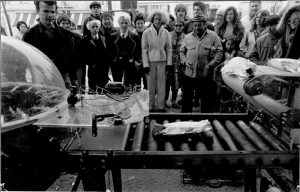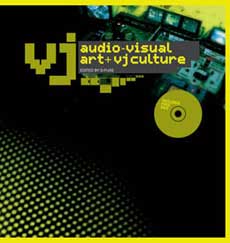 Audio-Visual Art and VJ Culture, edited by Michael Faulkner/ D-Fuse.
Audio-Visual Art and VJ Culture, edited by Michael Faulkner/ D-Fuse.
Editors’ blurb: A major change has taken place at dance clubs worldwide: the advent of the VJ. Once the term referred to the video jockey who introduced music videos on MTV, but now it defines an artist who creates and mixes video, live and synced to music, in clubs or at concerts. This book is an in-depth look at the artists at the forefront of this amazing audio-visual experience..
Let’s be honest: i bought this one because of the sleek cover. I’m not much of a clubber and i’m not a huge fan of screen-based art. Well, at least that’s what i thought before i opened the book and started to recognise the name of artists whose work i’ve enjoyed over the years, at concerts or events such as Club Transmediale.
The term VJ was used for the first time at the end of the ’70s in the Peppermint Lounge. However, the chapter dedicated to the history of VJing spans a period much longer than one might expect, tracing back the influences on the discipline to Joseph Plateau (the inventor of the phenakistiscope) and talking about the key-role that silent movies has paradoxically played in helping VJing develop its language. Silent film directors had to construct a narrative using mainly visual elements and the connection with VJing is further increased in the case of the screening of films accompanied by improvised music. Apart from cinema and videos, VJs’ work engages also with (graphic) design and interactive art.
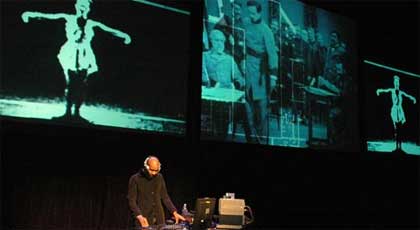 DJ Spooky– ReBirth of a Nation
DJ Spooky– ReBirth of a Nation
Over the pages, i’ve discovered several amazing projects that should convince anyone that VJing is not just clubland/underground entertainment, but a vivid art form. Just one example:
D-Fuse’s Small Global is a multichannel video/motion gfx installation that uses animated images and vector maps of the planet to explore environmental and immigration issues. Small Global juxtaposes visualizations of pairs of data sets to highlight relationships that often go unnoticed by mass media. For example, the mining and price of coltan (the metal used in mobile phone chips) in Congo is mapped against the human death toll and expertmination of Congo’s highland gorillas.
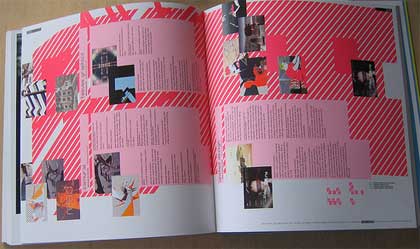
One of the biggest bonus of the book lies in the 150 interviews with artists at the forefront of the scene. Grouped by geographical region, each set of VJs’ portraits opens with an intro to the VJing scene in that particular location. They talk about who’s inspiring them (the usual suspects such as Bill Viola and the graffit culture but also Picasso, Burrough, the qatsi trilogy, etc.), how they deal with copyrights, their relationship with the advertising industry, how they financially sustain their work, the equipment they are working with, and the growing influence of their work on other industries and music video. Some of the interviewees are “wo/men of few words”, others have compelling stories to share.
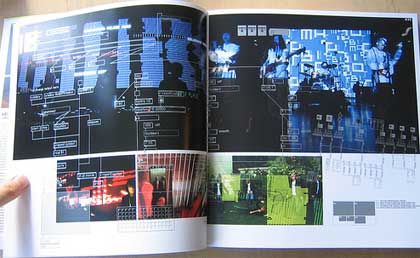
Last chapter of the book deals with VJ’s resources: the hardware, the software, the set-up. With tips from the VJs.
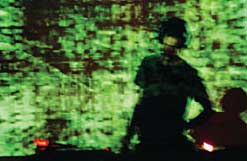 I enjoyed the book a lot which came as a surprise as i’m fairly ignorant of VJing. The illustrations are amazing and the fact that the pages have been written mainly by practioners makes the reading absorbing (that’s if you like the “insider view” style.) An expert in VJ culture might be more critical (and appreciate better than i did the chapter dedicated to the tools used by VJs) but i’d say that i’m a very satisfied customer.
I enjoyed the book a lot which came as a surprise as i’m fairly ignorant of VJing. The illustrations are amazing and the fact that the pages have been written mainly by practioners makes the reading absorbing (that’s if you like the “insider view” style.) An expert in VJ culture might be more critical (and appreciate better than i did the chapter dedicated to the tools used by VJs) but i’d say that i’m a very satisfied customer.
As you might expect, a 130 min’ DVD is hiding under the cover. It combines documentaries, videos and images from live performances by some of the most respected VJs such as The Light Surgeons, Actop, D-Fuse, UVA, 8gg, Elliott Earls, Coldcut/Hexstatic, Visual Kitchen, etc.
Pingmag recently interviewed Mike Faulkner.
Related: 8gg Big, In the mood for clubbing, Colder, Big tanks, Video printing.





